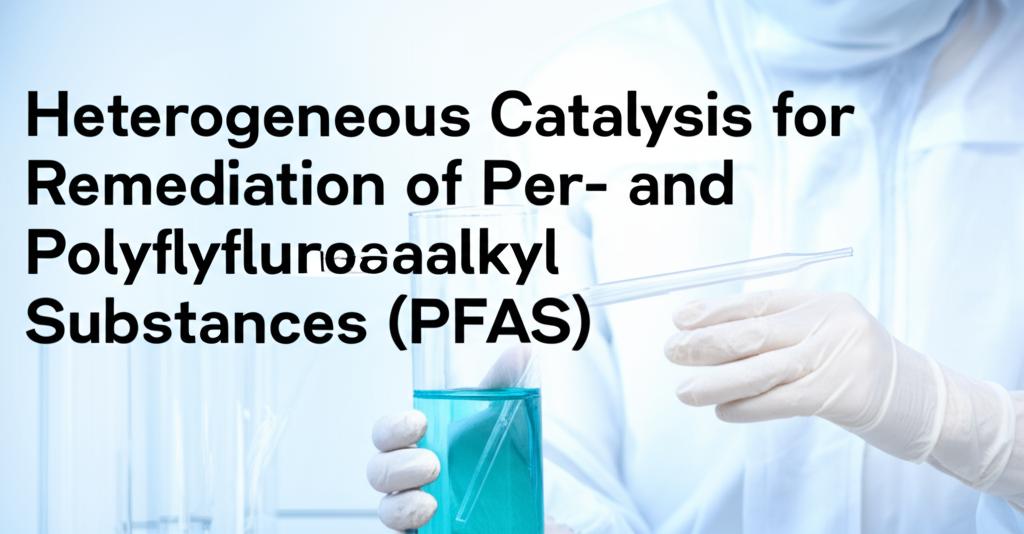Per- and polyfluoroalkyl substances (PFAS) are a large group of synthetic chemicals, sometimes called "forever chemicals," that are widespread in the environment and are linked to serious health risks. Their strong carbon-fluorine bonds make them incredibly resistant to breaking down naturally. Heterogeneous catalysis is emerging as a key technology to address this challenge by not just removing, but actually destroying PFAS molecules.
The Promise of Heterogeneous CatalysisUnlike conventional water treatment methods like reverse osmosis or activated carbon filtration, which only separate PFAS from water and create toxic sludge requiring further treatment, heterogeneous catalysis aims to completely mineralize PFAS. This process uses solid catalysts to accelerate chemical reactions, breaking down PFAS into benign end products such as carbon dioxide, fluoride ions, and water.
Recent Advancements and StrategiesResearchers are actively developing and refining heterogeneous catalytic approaches. Key areas of advancement include:
- Multistep Degradation: A new strategy involves a "treatment train" approach. Initial catalytic steps focus on cleaving the chemically diverse functional head groups from PFAS molecules. This simplifies the chemical mixture, making subsequent heterogeneous catalytic stages more effective. This modular, multistep strategy reframes PFAS destruction as a series of catalytic reactions rather than a single process.
- Catalyst Design and Optimization: Significant effort is going into designing catalysts with surfaces that better attract PFAS molecules. This improves the selectivity of the catalyst, ensuring it targets PFAS effectively even in the presence of other substances commonly found in contaminated water. Nanomaterials, with their high surface area and designed reactivity, are showing particular promise as photocatalysts. Materials like titanium and indium oxides, as well as iron-based nanocomposites, have demonstrated activity in PFAS degradation. Metal-organic frameworks (MOFs), particularly titanium-based ones, have also been explored as photocatalysts.
- Advanced Oxidation and Reduction Processes (AOPs/ARPs): Heterogeneous catalysis is often employed within AOPs and ARPs. These processes can use ozone, persulfate, hydrogen peroxide, and ultraviolet (UV) light. Photochemical heterogeneous catalytic AOPs have shown efficiency in degrading PFAS. Persulfate-based AOPs, which generate sulfate radicals, appear to be particularly effective oxidants for PFAS. Processes involving the hydrated electron and sulfate radical, especially when UV light is used, show high PFAS degradation efficiency.
- Understanding Degradation Pathways: Research is ongoing to better understand the precise mechanisms by which different PFAS break down under various catalytic conditions. The type of dominant reactive species (oxidizing or reducing) influences the degradation pathway. For instance, holes (electron vacancies on the catalyst surface) typically oxidize PFAS, leading to the loss of their head groups, while hydroxyl and superoxide radicals can break C-C and C-F bonds. Hydrated electrons, on the other hand, tend to directly remove the head group. The crystal facets and functional groups on the catalyst surface also play a role by influencing how PFAS molecules attach to the catalyst.
- New Evaluation Metrics: To better compare different catalytic systems, a new parameter called Electrical Energy per Order of Defluorination (EEOD) has been introduced. This metric quantifies the actual energy consumed to break the carbon-fluorine bonds, providing a more equitable way to evaluate the sustainability and efficiency of various technologies. This shifts the focus from mere removal efficiency to true destruction.
Despite promising advancements, several challenges remain:
- Complexity of PFAS Mixtures: PFAS encompass a vast group of over 15,000 substances, each with unique properties. Developing catalysts effective against this wide range of compounds is a significant hurdle. Pre-treatment steps using homogeneous catalysis (like oxidation or photoreduction) are being explored to simplify complex PFAS mixtures before applying heterogeneous catalysis.
- Scalability and Cost-Effectiveness: Transitioning these technologies from the lab to large-scale industrial applications requires overcoming cost and operational hurdles. Effective heterogeneous catalysts would be transformative for industrial-scale removal because the solid catalyst can be easily separated from the contaminated water, and the process is inherently more sustainable and scalable.
- Byproduct Formation: Incomplete decomposition of some PFAS can lead to the formation of other, potentially still problematic, short-chain PFAS byproducts. Research aims to achieve complete mineralization.
- Energy Efficiency: While destructive, some catalytic processes can be energy-intensive. Continued research focuses on improving energy efficiency to make these solutions more sustainable.
The development of innovative heterogeneous catalytic processes offers a structured pathway to address PFAS pollution. Continued interdisciplinary collaboration, along with open sharing of experimental data and modeling techniques, is crucial for translating these research advancements into widespread, real-world applications. The goal is to develop smart, sustainable catalytic technologies capable of complete PFAS destruction, safeguarding public health and environmental integrity for future generations. Simulation-guided design is also emerging as a central pillar in advancing these technologies.

